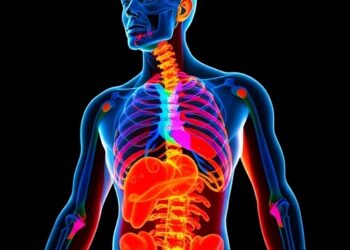UNIVERSITY PARK, Pa. — The key to developing quantum electronics may have a few kinks. According to a team led by researchers at Penn State, that’s not a bad thing when it comes to the precise control needed to fabricate and operate such devices, including advanced sensors and lasers. The researchers fabricated a switch to turn on and off the presence of kink states, which are electrical conduction pathways at the edge of semiconducting materials. By controlling the formation of the kink states, researchers can regulate the flow of electrons in a quantum system.
UNIVERSITY PARK, Pa. — The key to developing quantum electronics may have a few kinks. According to a team led by researchers at Penn State, that’s not a bad thing when it comes to the precise control needed to fabricate and operate such devices, including advanced sensors and lasers. The researchers fabricated a switch to turn on and off the presence of kink states, which are electrical conduction pathways at the edge of semiconducting materials. By controlling the formation of the kink states, researchers can regulate the flow of electrons in a quantum system.
“We envision the construction of a quantum interconnect network using the kink states as the backbone,” said team leader Jun Zhu, professor of physics at Penn State. Zhu is also affiliated with Penn State’s Center for 2-Dimensional Layered Materials. “Such a network may be used to carry quantum information on-chip over a long distance, for which a classical copper wire won’t work because it has resistance and therefore cannot maintain quantum coherence.”
The work, published recently in Science, potentially provides a foundation for researchers to continue investigating kink states and their application in electron quantum optics devices and quantum computers.
“This switch operates differently from a conventional switch, where the electrical current is regulated through a gate, similarly to traffic through a toll plaza,” Zhu said. “Here, we are removing and rebuilding the road itself”.
Kink states exist in a quantum device built with a material known as Bernal bilayer graphene. This comprises two layers of atomically thin carbon stacked together, in such a way that the atoms in one layer are misaligned to the atoms in the other. This arrangement, together with the use of an electric field, creates unusual electronic properties — including the quantum valley Hall effect.
This effect refers to the phenomenon of electrons occupying different “valley” states — identified based on their energy in relation to their momentum — also move in opposing forward and backward directions. Kink states are manifestations of the quantum valley Hall effect.
“The amazing thing about our devices is that we can make electrons moving in opposite directions not collide with one another — which is called backscattering — even though they share the same pathways,” said first author Ke Huang, a graduate student pursing a doctorate in physics at Penn State under Zhu’s mentorship. “This corresponds to the observation of a ‘quantized’ resistance value, which is key to the potential application of the kink states as quantum wires to transmit quantum information.”
While the Zhu lab has published on the kink states before, they only achieved the quantization of the quantum valley Hall effect in the current work after improving the electronic cleanness of the devices, meaning they removed sources that could allow electrons moving in opposite directions to collide. They did this by incorporating a clean graphite/hexagonal boron nitride stack as a global gate — or a mechanism that can allow the flow of electrons — into the devices.
Both graphite and hexagonal boron nitride are compounds commonly used as lubricant for paints, cosmetics and more. Graphite conducts electricity well while hexagonal boron nitride is an insulator. The researchers used this combination to contain electrons to the kink states and control their flow.
“The incorporation of a graphite/hexagonal boron nitride stack as a global gate is critically important to the elimination of electron backscattering,” Huang said, noting that this material use was the key technical advancement of the current study.
The researchers also found that the quantization of the kink states remains even when the temperature is raised to several tens of Kelvin, the scientific unit of temperature. Zero Kelvin corresponds to -460 degrees Fahrenheit.
“Quantum effects are often fragile and only survive at cryogenic temperatures of a few Kelvin,” Zhu said. “The higher temperature we can make this work, the more likely it can be used in applications.”
The researchers experimentally tested the switch they built and found that it could quickly and repeatedly control the current flow. This adds to the arsenal of kink state-based quantum electronics widgets that help control and direct electrons — valve, waveguide, beam splitter — previously built by the Zhu lab.
“We have developed a quantum highway system that could carry electrons without collision, be programmed to direct current flow and is potentially scalable — all of which lays a strong foundation for future studies exploring the fundamental science and application potentials of this system,” Zhu said. “Of course, to realize a quantum interconnect system, we still have a long way to go.”
Zhu noted that her lab’s next goal is demonstrate how electrons behave like coherent waves when traveling on the kink state highways.
Other authors include Hailong Fu, a former postdoctoral scholar and Eberly Fellow in physics at Penn State, and a current assistant professor at Zhejiang University, China; and Kenji Watanabe and Takashi Taniguchi, both with the National Institute for Materials Science in Japan.
The U.S. National Science Foundation, the U.S. Department of Energy, the Penn State Eberly Research Fellowship, the Kaufman New Initiative of the Pittsburgh Foundation, the Japan Society for the Promotion of Science and the World Premier International Research Initiative of Japan’s Ministry of Education, Culture, Sports, Science and Technology funded this research.
Journal
Science
Method of Research
Experimental study
Subject of Research
Not applicable
Article Title
High-temperature quantum valley Hall effect with quantized resistance and a topological switch
Article Publication Date
18-Jul-2024




